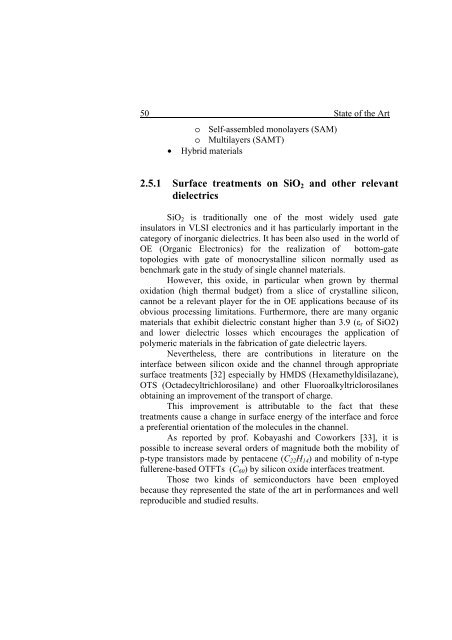tesi R. Miscioscia.pdf - EleA@UniSA
tesi R. Miscioscia.pdf - EleA@UniSA
tesi R. Miscioscia.pdf - EleA@UniSA
Create successful ePaper yourself
Turn your PDF publications into a flip-book with our unique Google optimized e-Paper software.
50 State of the Art<br />
o Self-assembled monolayers (SAM)<br />
o Multilayers (SAMT)<br />
• Hybrid materials<br />
2.5.1 Surface treatments on SiO2 and other relevant<br />
dielectrics<br />
SiO2 is traditionally one of the most widely used gate<br />
insulators in VLSI electronics and it has particularly important in the<br />
category of inorganic dielectrics. It has been also used in the world of<br />
OE (Organic Electronics) for the realization of bottom-gate<br />
topologies with gate of monocrystalline silicon normally used as<br />
benchmark gate in the study of single channel materials.<br />
However, this oxide, in particular when grown by thermal<br />
oxidation (high thermal budget) from a slice of crystalline silicon,<br />
cannot be a relevant player for the in OE applications because of its<br />
obvious processing limitations. Furthermore, there are many organic<br />
materials that exhibit dielectric constant higher than 3.9 (εr of SiO2)<br />
and lower dielectric losses which encourages the application of<br />
polymeric materials in the fabrication of gate dielectric layers.<br />
Nevertheless, there are contributions in literature on the<br />
interface between silicon oxide and the channel through appropriate<br />
surface treatments [32] especially by HMDS (Hexamethyldisilazane),<br />
OTS (Octadecyltrichlorosilane) and other Fluoroalkyltriclorosilanes<br />
obtaining an improvement of the transport of charge.<br />
This improvement is attributable to the fact that these<br />
treatments cause a change in surface energy of the interface and force<br />
a preferential orientation of the molecules in the channel.<br />
As reported by prof. Kobayashi and Coworkers [33], it is<br />
possible to increase several orders of magnitude both the mobility of<br />
p-type transistors made by pentacene (C22H14) and mobility of n-type<br />
fullerene-based OTFTs (C60) by silicon oxide interfaces treatment.<br />
Those two kinds of semiconductors have been employed<br />
because they represented the state of the art in performances and well<br />
reproducible and studied results.
















